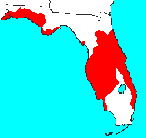
Range map, redrawn from (2). |
Pinus clausa
(Chapman ex Engelmann) Sargent 1884
Common NamesSand pine (1), spruce pine, scrub pine.Taxonomic notesSyn: Pinus inops Aiton var. clausa Chapman ex Engelmann 1877; P.clausa var. immuginata D.B. Ward (1).Description"Trees to 21 m; trunk to 0.5 m diam., straight and erect to leaning and crooked, much branched; crown mostly rounded or irregular. Bark gray to gray-brown, furrowed, with narrow, flat, irregular ridges, resin pockets absent, on upper sections of the trunk reddish to red-brown, platy becoming smooth distally. Branches spreading to ascending, poorly self-pruning; twigs slender, violet- to red-brown, rarely glaucous, aging gray, smooth. Buds cylindric, purple-brown, to 1cm; scale margins white-fringed. Leaves 2 per fascicle, spreading-ascending, persisting 2-3 years, (3-)6-9(-10) cm x ca. 1 mm, straight, slightly twisted, dark green, all surfaces with fine, inconspicuous stomatal lines, margins finely serrulate, apex short-conic; sheath 0.3-0.5(-0.7) cm, base persistent. Pollen cones ellipsoid, ca. 10 mm, brownish yellow. Seed cones maturing in 2 years, shedding seeds soon thereafter or often long-serotinous, 4 long-persistent, solitary or whorled, spreading, symmetric (rarely slightly asymmetric, reflexed), lanceoloid before opening, ovoid to broadly ovoid when open, 3-8 cm, red-brown, sessile or on stalks to 1 cm, scales with dark red-brown, purple, or purple-gray border distally on adaxial surface; apophyses thickened, shallowly and angulately raised, transversely rhombic, cross-keeled; umbo central, low-pyramidal, tapering to sharp tip or weak, often deciduous prickle. Seeds obovoid-oblique; body ca. 4 mm, dark brown to nearly black; wing to 17 mm. 2 n =24" (1).RangeUSA: Alabama and Florida, at 0-60 m. Found on sandy soils. Stands typically establish after fire (1). See also (3).Big TreeDiameter 70 cm, height 29 m, crown spread 12 m; also diameter 62 cm, height 30 m, crown spread 13 m; both located in Starkey Wilderness Park, FL ( American Forests 1996 ).OldestDendrochronologyEthnobotany"Although Pinus clausa is too profusely branched to be important for saw timber, it is managed to produce a high volume of pulpwood in northern peninsular Florida" (1).
Observations
Remarks
Citations(1) Robert Kral, in Flora of North America online .(2) Burns & Honkala 1990 . (3) Robert S. Thompson, Katherine H. Anderson and Patrick J. Bartlein. 1999. Atlas of Relations Between Climatic Parameters and Distributions of Important Trees and Shrubs in North America. U.S. Geological Survey Professional Paper 1650 A&B. URL= http://greenwood.cr.usgs.gov/pub/ppapers/p1650-a/pages/conifers.html , accessed 22-Jan-2000. See also: The FEIS database . |
|
[ Pinus ] [ Pinaceae ] [ home ]
This page is from the Gymnosperm Database
|